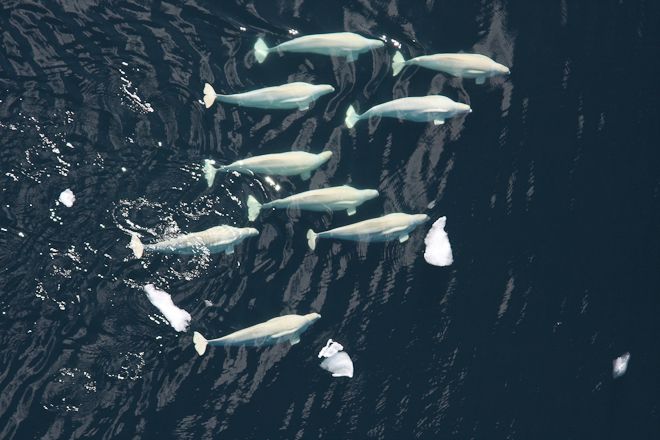
An orphaned narwhal swam away from its changing habitat and made some new friends.
The narwhal probably left its home in the Arctic—620 miles north—and swam down to the St. Lawrence River in eastern Canada. Scientists at the Group for Research and Education on Marine Mammals (GREMM) believe the narwhal has been hanging out with 10 male beluga whales for the past three years.
Narwhals, sometimes called the unicorns of the sea, are typically found in Arctic waters and spend their winters swimming under sea ice, according to the World Wildlife Foundation. They can weigh up to 4,200 pounds and can be about 17 feet long, and their 10-foot long tusk is actually a tooth. The tusk has up to 10 million nerve endings.
There are about 80,000 narwhals in the world, but they face threats from climate change and oil and gas development, among others. They are vulnerable to increases in the number of shipping vessels in their habitat, for example—the ships interfere with their communication, and sometimes collide with them.
"Due to the climate change being observed in the Arctic, there is a chance that these two related species (the beluga and narwhal belong to the same family: Monodontidae) might find themselves in one another's company more and more frequently in the decades to come," GREMM researchers wrote in a statement on their website. "We already see this phenomenon in other species such as the polar bear and the grizzly, which have even been observed to interbreed."
In a 1993 study, researchers claimed to have located a potential beluga and narwhal hybrid, but it was never confirmed by DNA testing. Belugas and narwhals, despite being closely related, are actually very different. Narwhals tend to dive and are comfortable in areas covered with dense ice. Belugas tend to spend their time in shallower coastal waters that have less ice. They eat fish, like salmon, that swim near the surface. However, the narwhal seems to interact with the whales normally, in exactly the same way the belugas interact with one another. It appears the narwhal has been fully accepted into the group of young males.
"It behaves like it was one of the boys," Robert Michaud, GREMM's president and scientific director, told the CBC. "They are in constant contact with each other. It's a like a big social ball of young juveniles that are playing some social, sexual games."
Whales have wandered away from their natural habitats in the past and can end up searching for companions. The scientists at GREMM have seen young whales try to go to New Jersey or Nova Scotia, but they sometimes get injured by boats or humans, and end up getting killed by propellers.
"That little narwhal that made a similar trip was very lucky," Michaud said. "Because he found almost normal buddies."
Uncommon Knowledge
Newsweek is committed to challenging conventional wisdom and finding connections in the search for common ground.
Newsweek is committed to challenging conventional wisdom and finding connections in the search for common ground.
About the writer
To read how Newsweek uses AI as a newsroom tool, Click here.








